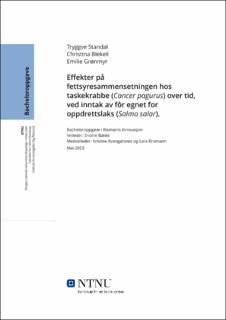| dc.contributor.advisor | Bakke, Snorre | |
| dc.contributor.advisor | Kvangarsnes, Kristine | |
| dc.contributor.advisor | Bromann, Lara | |
| dc.contributor.author | Standal, Tryggve | |
| dc.contributor.author | Blekeli, Christina | |
| dc.contributor.author | Grønmyr, Emilie | |
| dc.date.accessioned | 2023-07-04T17:22:18Z | |
| dc.date.available | 2023-07-04T17:22:18Z | |
| dc.date.issued | 2023 | |
| dc.identifier | no.ntnu:inspera:146720542:149498226 | |
| dc.identifier.uri | https://hdl.handle.net/11250/3075883 | |
| dc.description.abstract | Fôring av laks i tradisjonelle åpne merder fører ofte til utslipp av fôrrester. Flere villfisk- og bentiske arter utnytter den økte næringstilgangen i nærheten av oppdrettsanleggene. Fôret som brukes til oppdrettslaks består i stor grad av vegetabilske fettsyrer. Dette kan medføre at artene som tar opp denne næringen får redusert innhold av marine fettsyrer og økt innhold av vegetabilske fettsyrer. Vegetabilske fettsyrer som oljesyre, linolsyre og ALA er noen av fettsyrene som har blir brukt som biomarkører for å si noe om avtrykket oppdrett i åpne sjømerder har på miljøet rundt. Det er lite forskning på hvor raskt disse fettsyrene tas opp av marine arter som beiter på fôrspill rundt merder. I dette forsøket ble individer av taskekrabbe (Cancer pagurus) fôret på pellets egnet for laks. Hensikten med forsøket var å undersøke hvor lang tid det tar før det oppstår en signifikant endring i lever fettsyresammensetning. Analyse av prøvemateriale ble utført ved bruk av gasskromatografi. Resultatene viser en klar sammenheng mellom fôropptak og fettsyresammensetning. Allerede etter seks dager med fôring ble det funnet signifikant økning i alle tre vegetabilske fettsyrene og signifikant reduksjon i marine fettsyrer (p<0.05). Denne trenden vedvarte gjennom hele forsøksperioden. Informasjonen fra dette forsøket kan gi økt forståelse rundt miljøpåvirkningene oppdrett har på bentiske arter, samt være nyttig ved videre studier om vegetabilske fettsyrers innvirkning på marine arter. | |
| dc.description.abstract | Feeding salmon in traditional open cages often leads to release of feed residues. Several wild fish and benthic species take advantage of increased nutrient availability near farms. The feed used for farmed salmon consists largely of terrestrial fatty acids. Species that consume residues can have a reduced content of marine fatty acids and an increased content of terrestrial fatty acids. Terrestrial fatty acids such as oleic acid, linoleic acid and ALA are some of the fatty acids that have been used as biomarkers to describe impacts that open cage farms have on the surrounding environment. There is little research on how quickly marine organisms around farms absorb terrestrial fatty acids. In this scientific trial, individuals of Cancer pagurus were fed pellets suitable for farmed salmon. The focus of the thesis was to investigate how long it takes before a significant change occurs in the hepatopancreas’s fatty acid composition. Analysis of sample material was carried out using gas chromatography. The results show a correlation between feed intake and fatty acid composition. After six days of feeding, the data showed a significant increase in all terrestrial fatty acids and a significant decrease in marine fatty acids (p<0.05). Throughout the scientific trial this trend persisted. This research can be used to better understand the environmental impact farming has on benthic species, as well as being useful for further studies on the impact terrestrial fatty acids have on marine species. | |
| dc.language | nob | |
| dc.publisher | NTNU | |
| dc.title | Effekter på fettsyresammensetningen hos taskekrabbe (Cancer pagurus) over tid, ved inntak av fôr egnet for oppdrettslaks (Salmo salar). | |
| dc.type | Bachelor thesis | |
